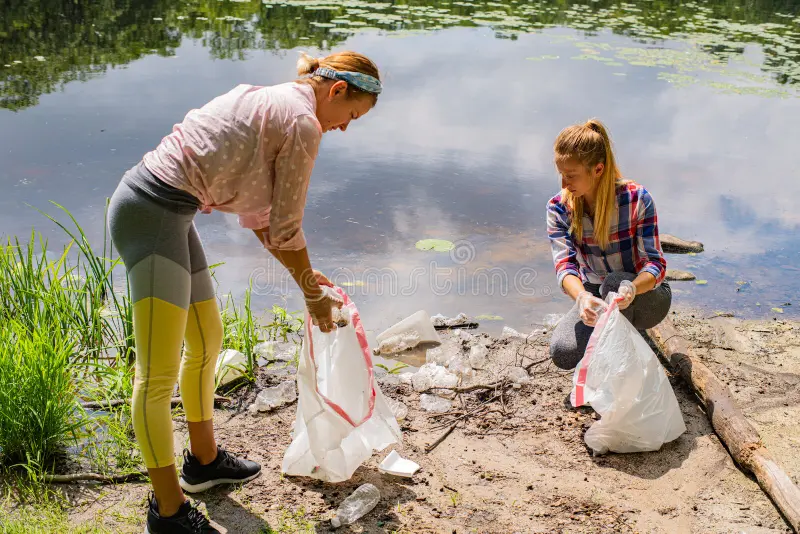
Spring has finally arrived, and if you’re like me, you can’t wait to trade the snow boots for flip flops and soak up that lakefront lifestyle we all love. But before you there’s one important thing we all need to tackle: cleaning up your shoreline. there’s one important thing we all need to tackle: cleaning up your shoreline.
Every spring, Mother Nature leaves a little mess behind—branches, leaves, random debris, maybe even a mystery flip-flop or two. A good spring shoreline cleanup isn’t just about making things look nice (though it definitely helps)—it’s about protecting your property, the health of the lake, and your summer enjoyment.
Let’s walk through it together. I’ve done this dozens of times, and I’m sharing my top tips for a smooth and successful spring cleanup.
Walk the Line (Your Shoreline, That Is)
First things first: take a walk along your shoreline and really look at what’s going on. This is your chance to spot:
- Fallen limbs or storm debris
- Trash washed up over the winter
- Signs of erosion or ice damage
- Weeds starting to creep in
- Any damage to your dock or retaining walls
- This is also a great time to take a few photos and notes so you can plan what tools and supplies you’ll need. Trust me—being prepared makes all the difference.

Get Your Tools Ready
Don’t show up empty-handed. Here’s what I always keep on hand for a good cleanup:
- Rake (I use a metal one for the heavy stuff and a leaf rake for the lighter stuff)
- Trash bags (get both regular and recycling if you can)
- Work gloves (your hands will thank you)
- Loppers or pruning shears
- Shovel or muck rake if you’ve got buildup
- Waders or boots—yep, you’re gonna get wet
- A cart or wheelbarrow to move everything
- Pressure washer for dock cleanup (optional, but worth it)
- Gather your gear first so you’re not running back to the shed mid-job.
Start With Trash & Debris
Begin by picking up any trash that’s made its way to your shoreline—plastic bottles, fishing line, cans, wrappers… it’s amazing what turns up. That stuff doesn’t belong anywhere near your lake.
Then move on to natural debris—branches, leaves, and dead plants. Too much of this material can clog up your shoreline, block sunlight, and eventually turn into muck. A quick rake-through will do wonders.
Just be careful not to rip out healthy shoreline plants—some are there for a reason!

Watch Out for Invasives
This one’s big. Invasive species like purple loosestrife, phragmites, or milfoil can sneak in and take over before you know it. Spring is the best time to pull them—roots and all—before they spread.
If you’re not sure what’s what, check with your local lake association or conservation office. Better to be safe than sorry.
Prune, Don’t Pillage
If you’ve got overgrown bushes, small trees, or tall grasses along the shore, feel free to clean them up. Cut away dead or broken branches and trim things back a bit.
But don’t go too far. Native shoreline vegetation helps prevent erosion and filters out runoff. Keep a healthy buffer between your lawn and the water. It’s good for the lake—and looks great, too.
Replant Where It Counts
See bare patches or areas where water’s eating away the soil? That’s your cue to replant.
Use native plants with strong root systems—things like blue flag iris, pickerelweed, or switchgrass. These plants hold soil in place, block runoff, and help keep your shoreline in shape for years to come.
It’s a small effort now that pays off big time later.

Give the Dock Some Love
Your dock’s been through a lot over the winter. Give it a good once-over:
- Tighten bolts and replace worn boards
- Power wash to remove grime or mildew
- Check for loose railings or rusted hardware
- Also give your retaining walls and walkways a look. Clean out any weeds, and make minor repairs before they become big problems.
Handle Muck and Algae the Right Way
If your shoreline’s gotten mucky, you’re not alone. I’ve worked with plenty of lakefront owners dealing with this exact issue. Use a muck rake or lake rake to pull out the soft, decaying matter.
But—don’t go dumping chemicals in the water to handle it. That can do more harm than good. If it’s out of control, call in a lake management pro.
Same goes for algae. If you see weird discoloration or a blue-green film, stop and get it tested. Some blooms can be toxic.
Create a Buffer Zone
This one’s near and dear to my heart. The best long-term shoreline protection plan? A natural buffer zone.
That’s just a fancy way of saying: plant native shrubs, grasses, and trees between your yard and the lake. It helps:
- Absorb runoff
- Block excess nutrients
- Stop geese from turning your yard into their bathroom
- Keep erosion in check
- And bonus—it looks amazing.

Make It a Community Thing
Got lakefront neighbors? Organize a Shoreline Cleanup Day. Everyone pitches in, and you get a cleaner, healthier lake in return. Plus, it’s a great excuse to catch up over coffee or a cold beverage.
Check with your lake association or town—sometimes they’ll provide dumpsters or pick up debris.
Wrapping It Up
Listen—I know it’s tempting to jump straight to the hammocks and happy hours. But trust me, putting in the work now makes all the difference come summer.
A clean, well-maintained shoreline doesn’t just look great—it protects your investment, supports the lake’s health, and makes your time at the water that much better.
So roll up your sleeves, get the family involved, and show your lakefront a little love this spring.
See you out there—
Scott “The Lake Guy” Freerksen
